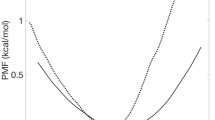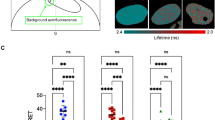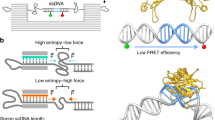Abstract
Gene regulation can be tightly controlled by recognition of DNA deformations that are induced by stress generated during transcription1,2,3. The KH domains of the FUSE-binding protein (FBP), a regulator of c-myc expression1,4, bind in vivo and in vitro to the single-stranded far-upstream element (FUSE), 1,500 base pairs upstream from the c-myc promoter4,5,6. FBP bound to FUSE acts through TFIIH at the promoter4. Here we report the solution structure of a complex between the KH3 and KH4 domains of FBP and a 29-base single-stranded DNA from FUSE. The KH domains recognize two sites, 9–10 bases in length, separated by 5 bases, with KH4 bound to the 5′ site and KH3 to the 3′ site. The central portion of each site comprises a tetrad of sequence 5′d-ATTC for KH4 and 5′d-TTTT for KH3. Dynamics measurements show that the two KH domains bind as articulated modules to single-stranded DNA, providing a flexible framework with which to recognize transient, moving targets.
This is a preview of subscription content, access via your institution
Access options
Subscribe to this journal
Receive 51 print issues and online access
$199.00 per year
only $3.90 per issue
Buy this article
- Purchase on Springer Link
- Instant access to full article PDF
Prices may be subject to local taxes which are calculated during checkout



Similar content being viewed by others
References
Liu, J. et al. Defective interplay of activators and repressors with TFIIH in xeroderma pigmentosum. Cell 104, 353–363 (2001).
Rothman-Denes, L. B., Dai, X., Davydova, E., Carter, R. & Kazimierczak, K. Transcriptional regulation by DNA structural transitions and single-stranded DNA binding proteins. Cold Spring Harbor Symp. Quant. Biol. 63, 63–73 (1999).
Michelotti, E. F., Sanford, S. & Levens, D. Marking of active genes on mitotic chromosomes. Nature 388, 895–899 (1997).
Liu, J. et al. The FBP interacting repressor targets TFIIH to inhibit activated transcription. Mol. Cell 5, 331–341 (2000).
Duncan, R. C. et al. A sequence-specific, single strand binding protein activates the far-upstream of c-myc and defines a new DNA binding motif. Genes Dev. 8, 465–480 (1994).
Michelotti, G. A. et al. Multiple single-stranded cis elements are associated with activated chromatin of the human c-myc gene in vivo. Mol. Cell. Biol. 16, 2656–2669 (1996).
Burd, C. G. & Dreyfuss, G. Conserved structures and diversity of functions of RNA binding proteins. Science 265, 615–621 (1994).
Clore, G. M. & Gronenborn, A. M. Determining structures of larger proteins and protein complexes by NMR. Trends Biotechnol. 16, 22–34 (1998).
Lewis, H. A. et al. Sequence-specific RNA binding by a Nova KH domain: implications for paraneoplastic disease and the fragile X syndrome. Cell 100, 323–332 (2000).
Baber, J. L., Libutti, D., Levens, D. & Tjandra, N. High precision solution structure of the C-terminal KH domain of heterogeneous nuclear ribonucleoprotein K, a c-myc transcription factor. J. Mol. Biol. 289, 949–962 (1999).
Musco, G. et al. Three-dimensional structure and stability of the KH domain: molecular insights into the fragile X syndrome. Cell 85, 237–245 (1996).
Saenger, W. Principles of Nucleic Acid Structure (Springer, New York, 1984).
Gorenstein, D. G. Conformation and dynamics of DNA and protein-DNA complexes by 31P NMR. Chem. Rev. 94, 1315–1138 (1994)..
Clore, G. M., Starich, M. R. & Gronenborn, A. M. Measurement of residual dipolar couplings of macromolecules aligned in the nematic phase of a colloidal suspension of rod-shaped viruses. J. Am. Chem. Soc. 120, 10571–10572 (1998).
Clore, G. M., Gronenborn, A. M. & Bax, A. A robust method for determining the magnitude of the fully asymmetric alignment tensor of oriented macromolecules in the absence of structural information. J. Magn. Reson. 131, 159–162 (1998)
Braddock, D. T., Cai, M., Baber, J. L., Huang, Y. & Clore, G. M. Rapid identification of medium to large scale interdomain motion in modular proteins using dipolar couplings. J. Am. Chem. Soc. 123, 8634–8635 (2001).
Clore, G. M. et al. Deviations from the simple two-parameter model-free approach to the interpretation of nitrogen-15 nuclear magnetic relaxation of proteins. J. Am. Chem. Soc. 112, 4989–4990 (1990).
Baber, J. L., Szabo, A. & Tjandra, N. Analysis of slow interdomain motion of macromolecules using NMR relaxation data. J. Am. Chem. Soc. 123, 3953–3959 (2001).
Lipari, G. & Szabo, A. Model-free approach to the interpretation of nuclear-magnetic-relaxation in macromolecules. 1 Theory and range of validity. J. Am. Chem. Soc. 104, 4546–4559 (1980).
Cantor, C. R. & Schimmel, P. R. Biophysical Chemistry Part II, 564 and Part III, 1008–1010 (Freeman, San Francisco, 1980).
Kim, T.-K., Ebright, R. H. & Reinberg, D. Mechanism of ATP-dependent promoter melting by transcription factor IIH. Science 288, 1418–1421 (2000).
Avigan, M. I., Stober, B. & Levens, D. A far upstream element stimulates c-myc expression in undifferentiated leukemia cells. J. Biol. Chem. 265, 18538–18545 (1990).
Grandori, C., Cowley, S. M., James, L. P. & Eisenman, R. N. The Myc/Max/Mad network and the transcriptional control of cell behavior. Annu. Rev. Cell Dev. Biol. 16, 653–699 (2000).
He, L. et al. Loss of FBP function arrests cellular proliferation and extinguishes c-myc expression. EMBO J. 19, 1034–1044 (2000).
Cornilescu, G., Delaglio, F. & Bax, A. Protein backbone angle restraints from searching a database of protein chemical shift and sequence homology. J. Biomol. NMR 31, 289–302 (1999).
Schwieters, C. D. & Clore, G. M. Internal coordinates for molecular dynamics and minimization in structure determination and refinement. J. Magn. Reson. 152, 288–302 (2001).
Clore, G. M. & Gronenborn, A. M. New methods of structure refinement for macromolecular structure determination by NMR. Proc. Natl Acad. Sci. USA 95, 5891–5898 (1998).
Schwieters, C. D. & Clore, G. M. The VMD-XPLOR visualization package for NMR structure refinement. J. Magn. Reson. 149, 239–244 (2001).
Nicholls, A., Sharp, K. A. & Honig, G. Protein folding and association: insights into interfacial and thermodynamic properties of hydrocarbons. Proteins 17, 297–309 (1991).
Clore, G. M. & Garrett, D. S. R-factor, free R and complete cross-validation for dipolar coupling refinement of NMR structures. J. Am. Chem. Soc. 121, 9008–9012 (1999).
Acknowledgements
We thank D. Garrett and F. Delaglio for software support; C. A. Bewley, M. Caffrey, W. A. Eaton, J. Kuszewski, L. Murphy, C. Schwieters, A. Szabo and N. Tjandra for discussions; and C. A. Bewley for critically reading the manuscript. This work was supported in part by the AIDS Targeted Antiviral Program of the Office of the Director of the National Institutes of Health (to G.M.C.).
Author information
Authors and Affiliations
Ethics declarations
Competing interests
The authors declare no competing financial interests.
Supplementary information
Rights and permissions
About this article
Cite this article
Braddock, D., Louis, J., Baber, J. et al. Structure and dynamics of KH domains from FBP bound to single-stranded DNA. Nature 415, 1051–1056 (2002). https://doi.org/10.1038/4151051a
Received:
Accepted:
Issue Date:
DOI: https://doi.org/10.1038/4151051a
This article is cited by
-
tiRNA-Val-CAC-2 interacts with FUBP1 to promote pancreatic cancer metastasis by activating c‑MYC transcription
Oncogene (2024)
-
Identification of a key glioblastoma candidate gene, FUBP3, based on weighted gene co-expression network analysis
BMC Neurology (2022)
-
LCAT3, a novel m6A-regulated long non-coding RNA, plays an oncogenic role in lung cancer via binding with FUBP1 to activate c-MYC
Journal of Hematology & Oncology (2021)
-
Qki activates Srebp2-mediated cholesterol biosynthesis for maintenance of eye lens transparency
Nature Communications (2021)
-
Comparative structural analyses and nucleotide-binding characterization of the four KH domains of FUBP1
Scientific Reports (2020)
Comments
By submitting a comment you agree to abide by our Terms and Community Guidelines. If you find something abusive or that does not comply with our terms or guidelines please flag it as inappropriate.



